古早海澄人
文图·杨宜瑾
19、20世纪间,东南亚一带的福建人中有为数不少的海澄籍贯。新加坡的名人中就有陈笃生、颜永成、李振殿、林推迁、林文庆、邱菽园、谢安详和杨清海。林推迁和杨清海同是中华总商会前身中华商务总会的首任委员。当时的海澄指的是福建省海澄县。
根据中国社会科学出版社2005年出版之《中国历史地名大辞典》,海澄县初置于明朝嘉靖四十四年(1565年),属漳州府。漳州府府属十县还包括龙溪、漳浦、长泰、南靖、诏安、平和、云霄、东山和华安。 1913年海澄县属福建西路道,1914年属汀漳道,1928年直属福建省,1960年海澄县大部分地区与龙溪县合并,成为龙海县,海澄县从此走入历史。
遗铭布朗碑
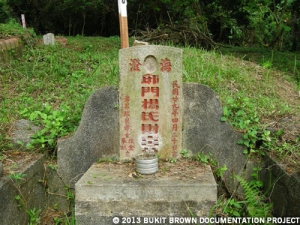
墓一-武吉布朗记录工作组提供
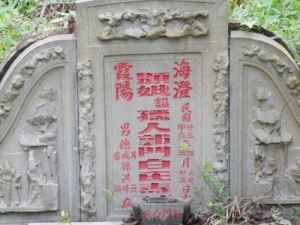
墓二-林志强先生提供
福建多山,因土地贫瘠,农耕不足,沿海一代居民自古以来便有向海讨食的天命,从简单的拾蛤捕鱼维生开始,从五代到宋元,逐渐发展的海洋贸易发掘了福州和泉州两大港口。明朝施行海禁之后,贸易出海都属非法,但这并不能完全杜绝海民的冒险行径。这时比较南端的九龙江口,反倒因为偏僻的地理环境演变成出海接通外国商船的隐秘岸口,走私贸易日益扩张,于是九龙江口沿岸到厦门岛入海处,大小港口纷纷建立,港群列岸,形成“外通海潮,内接山涧,其形似月”的月港。由于官、民、商、盗竞相抢盘夺利,朝庭一方面要治办倭寇与外商,一方面也因有利可图,遂设海澄县镇,加强管制。极盛时期,月港取代了福、泉两港的地位,海澄县也成为当时“市镇繁华甲一方,港口千帆竟相发”地处中国南方的经济特区。海澄的繁荣,进一步带动了近海内陆乡村如新垵、霞阳、青礁等地更多的宗氏族群相率下南洋,把 “海澄”和“漳州海澄”的地名传播到东南亚各地,跟随着海澄人的踪迹记录在官方档案、宗乡会馆的史料里,遗留在墓地里的碑刻上。
然而,“海澄”作为海澄县毕竟是个历史名词,在今日中国福建省地图上能找到的海澄,只是个“镇”,即是从前漳州府设置在海澄县九龙江口的府城镇。漳州府也是个历史名词,今日的漳州有两个身份,一个是市政区的“市”,另一个是市政府所在的“市”(镇)。古早的“漳州海澄”指的是漳州府海澄县,地域幅员大大地超过了今日一些寻根旅游景点标示的“漳州海澄”—那不过是漳州市政区内龙海县的城区镇海澄镇。
左面这幅地图,大地图根据星洲漳州总会金禧纪念特刊(1979年)第74页的海澄县全图的地形复制,主要划出明清时代海澄县的地理范围。左上角的小地图是当今福建省沿海部分厦门市政区和部分漳州市政区,小方格即是大地图展示的大略位置。
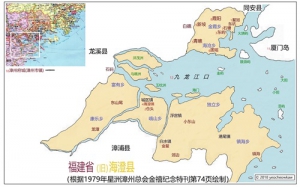
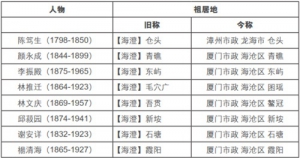
慎做海沧客
根 据《 新 华历史人物列传》整理出来的人物索引(国立大学中文图书馆网http://libguides.nus.edu.sg/c.php?g=145667&p=954457),其中有不下50位人物籍贯海澄。槟城南洋民史纂修馆编辑部编录的南洋名人集传全3000多人,其中也有150多位福建海澄人。这些名人中的名人,其祖乡详情原来不知道的也都经过史家或后人追踪考察,大部分已记录在后来的史料里。2015年出版的《新加坡华人通史》,也不再单纯地记述新加坡名人是什么省县人士,而是还原了他们祖乡的村名,并清楚冠之以现在的行政区划名,如记述林义顺祖乡是广东省澄海县岐山镇马西村,陈笃生祖乡是福建省龙海县仓头村后许社等等。
同称呼的地名容易造成误会。其实,上文所述的“府”、“县”、“ 乡 ” 、“ 区 ” 、“ 市 ” 、“镇”等同名的称呼不过是不同年代行政区域改组的演变。如图所示,海澄县和海澄镇是多么不同的观念。当年同样从“海澄”下南洋的华裔后人若不知道原来的祖乡村名,以为回到海澄镇就能寻根,恐怕都要大失所望。这里所示的海澄祖乡多数集中在现在的海沧区,都在旧“海澄”县东北,和同期属于旧“同安”县的集美村(陈嘉庚祖乡)同样比较靠近厦门岛;因此可以理解为什么现在它们都属厦门市管辖了。此外,为了集中规划侨乡政策,“海沧”也从原来的海沧乡升格为海沧区。虽然目前还没有正式的统计数字,但是可以推测大部分旧海澄人,现在都算海沧人!
漳州之旅
笔者祖乡霞阳,不久前,收到一份旅行社为一个槟城霞阳宗亲策划的海澄探亲旅程,竟是这么安排的: 探亲团先飞去泉州,第二站在漳州市进行探亲活动,之后飞回泉州,再从泉州去厦门,旅游完厦门便飞回槟城。泉州作为大方位理解华侨历史的寻根之旅的重要据点没有错,但在梳理了历史和地理的纠结之后,旅行社就有必要更加确认探亲团的祖乡何处,至少“海澄”探亲活动不应当轻易地规划在漳州之旅!
(作者为国大副教授,现已退休)
The Early Haicheng People
Between the 19th and 20th centuries, many Chinese Fujian (Hokkien) people in Singapore and Malaya were known to have come from Haicheng (Haiteng/Haitîng). These included celebrity pioneers such as Tan Tock Seng, Lim Boon Keng, and several others. At that time, ‘Haicheng’ referred to the Haicheng County, a substantially large region in the Fujian province, as shown on a map found in the Golden Jubilee Memorial magazine published by the Chang Chow General Association in Singapore in 1979. Today, however, Haicheng County is an obsolete name. On a modern map of Fujian, Haicheng is marked only as a historical town in the present-day Zhangzhou Municipal District, located at the mouth of the Jiulong Jiang River. (*Zhangzhou is the Hanyupinyin name of Chang Chow, as Fujian is to Hokkien, or Haicheng to Haiteng/Haitîng.)
Fujian is mostly mountainous and lacks fertile land for agricultural farming. Since ancient times, residents along the coastlines have had to seek food and living by venturing into the sea. Due to its peculiar geographical environment, areas along the Jiulong River developed vibrant maritime activities. During its heyday, they were even hailed as the Moon Harbour, with continuous market places noted in flying-colours in travelogs centuries ago. Haicheng County was thus like the special economic zone in southern China at that time.
The prosperity of Haicheng further prompted more inland villagers from places such as Xin’an (Sin-wa), Xiayang (A-yeo) and Qingjiao (Tshingtsiau), to migrate to the southern sea, Nanyang. The geographical names of [Haicheng] and [Zhangzhou Haicheng] started to spread in Southeast Asia. Following the traces of Haicheng people, they were recorded in official archives, historical materials of clan associations, and left inscribed on cemetery tombstones.
Out of over 3000 names of Nanyang Chinese in Singapore identified from two different lists that had records of ancestral birthplaces, 50 Haicheng people were identified from one list and 150 from the other. Even without official statistics, it is believed that most Haicheng people came from the northeast region of Haicheng County. This is supported by the renaming of this region as the region of overseas Chinese homes, known as the Haicang region, and put under the administrative governance of the present Xiamen Municipal District. Among the eight Haicheng celebrities, Tan Tock Seng, Gan Eng Seng, Lee Chin Tian, Lim Chwee Chian, Lim Boon Keng, Khoo Seok Wan, Chia Ann Siang and Yeo Cheng Hai, Tan Tock Seng was the only who had Haicheng roots located beyond Haicang and in Zhangzhou Municipal District.
Not all earlier Haicheng people carried on the names of their actual ancestral villages in their families and remembered by generations. Due to the namesake confusion, those [Haicheng] or [Zhangzhou Haicheng] descendants who are not certain about the exact ancestral hometown might want to look beyond Haicheng Town in Zhangzhou before embarking on travel itinerary plans put forth by any travel agency.


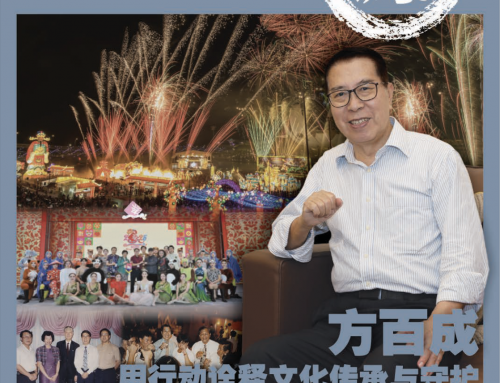
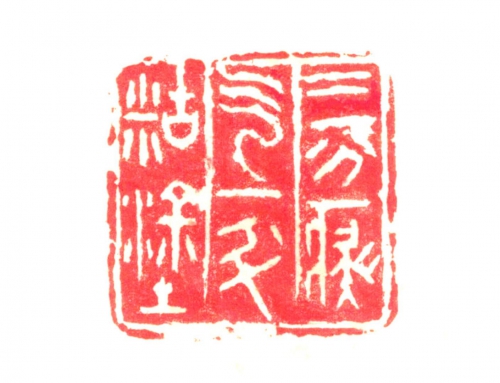

-scaled-500x383.jpg)
